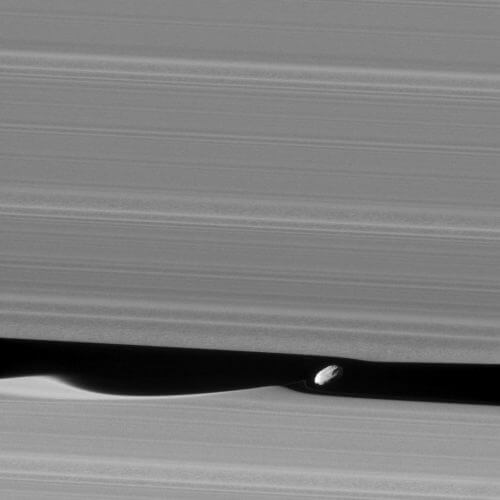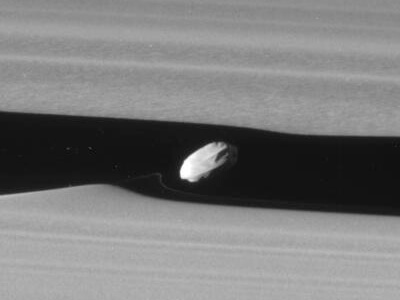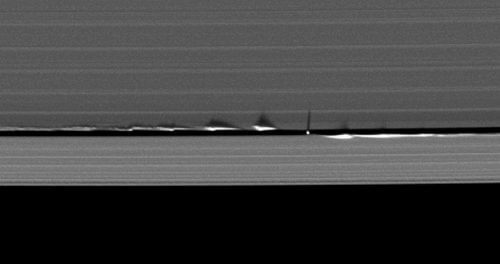Daphnis, a small moon of Saturn located in the space between its rings, was revealed in a new image by the Cassini probe.

Dephins was first discovered in 2005 by the Cassini spacecraft. It is found in the Keeler gap inside Saturn's A ring. It is an elongated body with a length of 8 km and a width of roughly 4-3.5 km and a density of -0.34. Upon its discovery, a number of photographs were taken of it. On 16.1.2017 he was photographed again, this time from a shorter distance. The distance of the passage of the Cassini near it was 27,000 km and the photograph was taken with a resolution of 168 meters per pixel. A high enough resolution that makes it possible to distinguish various details on its surface. From its low density it can be assumed that there is water in it and that it is very porous. There are probably many spaces in it.
In this photograph you can see that it is a longitudinal body. In the photo you can see the surface of half of it. You see very little of the upper half of the lower half. In this half it is possible to distinguish part of two impact craters. The upper half can be divided into three. In the right part you can see two reliefs, probably ridges crossing each other. The ridge "sitting" on the equator is brighter than the other ridge. In the center, a grayish straight part (the photograph is in black and white). It seems to be dust. The left part is very bright, with strong light reflection. It could be water ice. In several places the texture of the soil is granular. It is likely that during its movement within the Keeler interval, the moon adsorbs dust and ice particles from the A ring.
It is appropriate to collect the photographs in which this magazine appears for the purpose of independent research. In this study it will be possible to examine how stable the course of the moon is. There is a possibility that during its movement around Saturn the moon migrates from one end of the interval to the other. If its porosity is very large, then the gravity is smaller than one might assume. As it approaches one rim, one pole absorbs dust and ice from the ring and as it moves away, these particles escape from it. As it moves away from this rim, it approaches the other rim and then the other pole absorbs dust and ice particles. If this hypothesis is correct, then there is a cycle of attraction and escape of dust and ice particles from the poles. Such a study should be done at the end of the Cassini program, when the researchers will have all the photographs. It might then be possible to map this moon and get to know its surface better. The most intriguing question is how the monthly got to this place.


More on the science website:
- Saturn's rings are revealed in unprecedented detail in new Cassini images
- Pandora, a small moon of Saturn, has been revealed in new Cassini images, January 7, 2017
- Cassini will approach the rings on the last mission before crashing into Saturn, December 4, 2016
- Has the mystery of the formation of Saturn's rings been solved?, November 5, 2016
